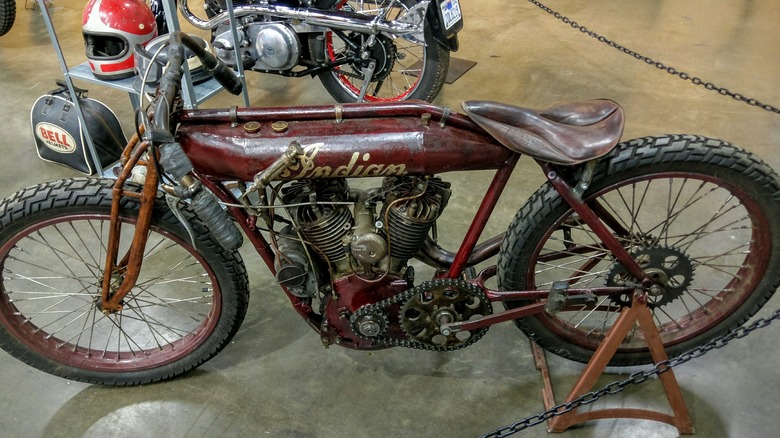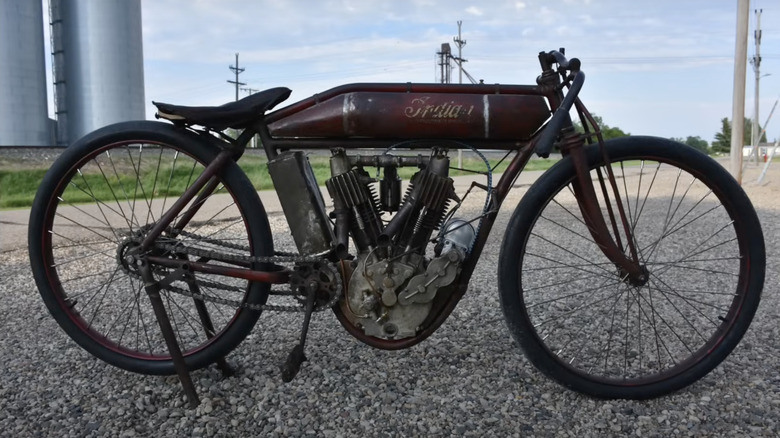3 Classic Indian Motorcycles That Are Worth A Small Fortune
Indian Motorcycle is one of the oldest vehicle manufacturers in the world, stating on its website that its history dates back to 1897 when George Hendee founded the Hendee Manufacturing Company to produce bicycles, working alongside co-founder Oscar Hedstrom. The Indian name was first used in 1923, after the company had shifted its focus to motor-powered two-wheelers.
The company produced around 85,000 motorcycles for the U.S. Army during World Wars I and II, but suspended operations in 1953, after which the brand went through a series of ownership changes. Polaris Industries bought Indian in 2011 and has overseen the brand's resurgence in the years since. Under Polaris, Indian produced its most powerful V-twin engine ever, the 122-horsepower PowerPlus 108.
Indian enjoys a healthy rivalry with Harley-Davidson, although its 50-plus year hiatus is one of the reasons Harley maintains a much larger market share. Indian's proud history includes the remarkable feat of building the Scout on which Burt Munro set a land speed record in 1967. That under 1000cc class record stands to this day, despite major advances in engine and chassis technology. Some of Indian's classic and antique models are worth a hefty sum these days, even though the lineage of the company has been interrupted since they were produced.
[Featured image by Cullen328 via Wikimedia Commons | Cropped and scaled | CC By-SA 3.0]
1928 Indian Ace
In January 2024, a 1928 Indian Ace like the one in the video above sold via Mecum Auctions for exactly $220,000. The bike that fetched that impressive figure was part of the private collection of Wayne Kruty of Prospect Heights, Illinois. Kruty painstakingly restored the bike a decade ago and had the inline four-cylinder engine and three-speed transmission rebuilt by Davies Antique Motors.
The origin of the Ace reaches back to 1910, when brothers Tom and William Henderson designed a prototype model and dubbed it the Henderson Four. William updated the model a decade later, calling his new line Ace.
His new company only made motorcycles for four years and was purchased by Indian in 1927. The first Indian Ace, the 401, was released that April and saw some significant changes over the next 16 months. Lighter pistons and a new camshaft were introduced along with a lower seat and new lubrication system in early 1928.
In August of that year, the model was given a new chassis and body reminiscent of the 101 Scout and rebadged as the Indian Four. A 1930 Indian Four sold about a week before the 1928 Ace and brought $205,000.
A Pre-World War I Indian Twin Board Track Racer
In 1908, Indian produced its first purpose-built racing motorcycle, and by 1911 the manufacturer was dominating the sport. Indian bikes swept all three podium places at that year's Isle of Man Tourist Trophy road race, and Indian motorcycles made for board track racing were equally as impressive. A 1912 Board Track Racer with a 61-cubic inch V-twin like the one shown above sold for $253,000 in 2019.
Unlike the example in the photo, the $253,000 racer was meticulously restored to its original glory by Indian wizard Jim Prosper. Prosper rebuilt the magneto and Hedstrom carburetor and gave the racer a gleaming coat of red paint. The bike won Antique Motorcycle Club of America (AMCA) awards in the Junior First and Senior categories, but it's not even the most valuable Board Track Racer from its era to change hands in the past few years.
1915 Indian 8-Valve Board Track Racer
That honor of the most-valuable Indian Board Track Racer goes to a 1915 model in glorious original condition that went for $285,000 in August of 2023. This example was in the same brilliant red as the 1912 Indian Board Racer with gold script manufacturer's logo on the fuel tank, but the 1915's engine is just one of four remaining Board Track Racer V-twins with an eight-valve architecture.
Unlike the one in rougher condition in the video above, it had a prototype Keystone-Marion frame with a curved front member to accommodate the front racing fork. This bike was sold with the original cylinder covers, although the engine behind them had been rebuilt.
It won the Red Wolverton and Junior First AMCA awards in 1998, the same year it was featured at the Guggenheim Museum's "The Art of the Motorcycle" exhibit. That summertime display also included a BMW R32, the first motorcycle from that maker, and a Honda Super Cub, a model that debuted in 1958 and has seen a production run of over 100 million units.

